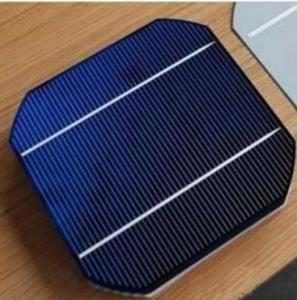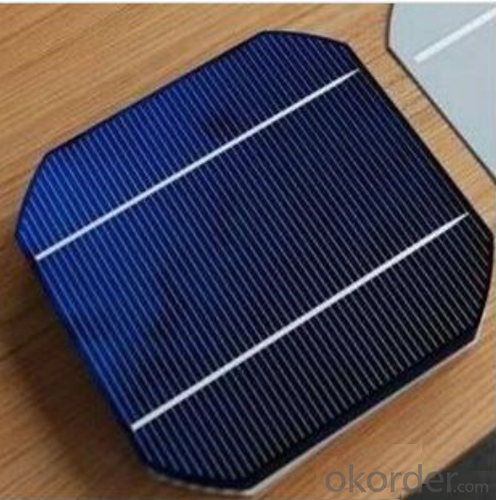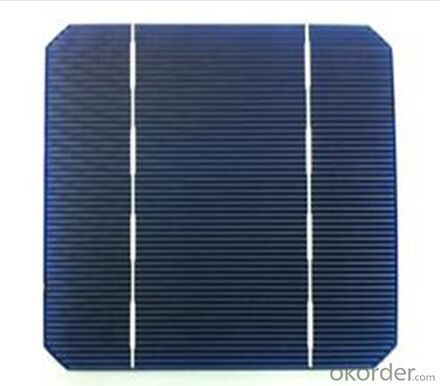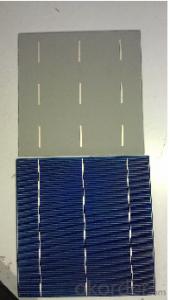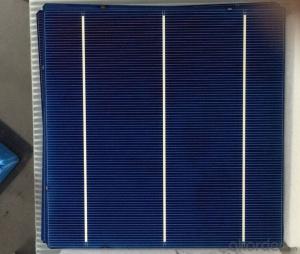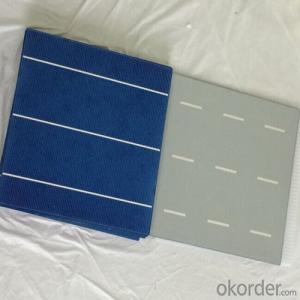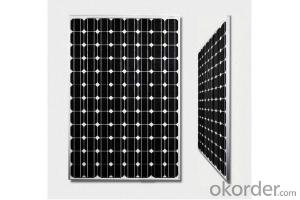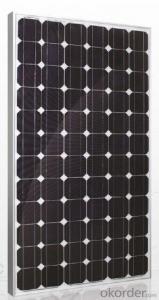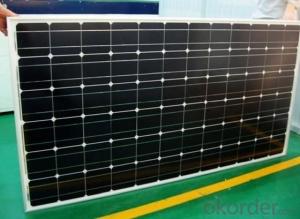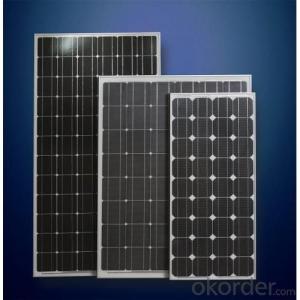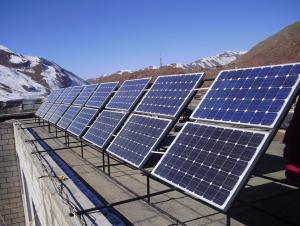Monocrystalline Solar Cell for Solar PV Panel
- Loading Port:
- China main port
- Payment Terms:
- TT or LC
- Min Order Qty:
- 10000 watt
- Supply Capability:
- 10000000 watt/month
OKorder Service Pledge
OKorder Financial Service
You Might Also Like
1. Structure of Monocrystalline Solar Cell for Solar PV Panel Description
A solar cell, or photovoltaic cell, is an electrical device that converts the energy of light directly into electricity by the photovoltaic effect,
which is a physical and chemical phenomenon. It is a form of photoelectric cell, defined as a device whose electrical characteristics, such
as current, voltage, or resistance, vary when exposed to light. Solar cells are the building blocks of photovoltaic modules, otherwise known
as solar panels.
2. Main Features of the Monocrystalline Solar Cell for Solar PV Panel
• High module conversion efficiency, through superior manufacturing technology
• 0 to +5W positive tolerance for mainstream products
• Certified to withstand high wind loads and snow loads
• Anodized aluminum is mainly for improving corrosion resistance
• Anti-reflective, Highly transparent, low iron tempered glass
• Excellent performance under low light environment
3. Monocrystalline Solar Cell for Solar PV Panel Images
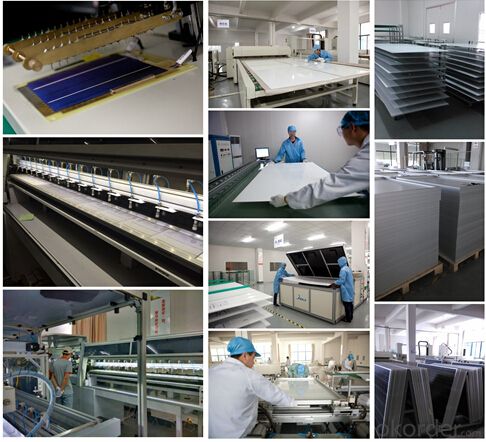

4. Monocrystalline Solar Cell for Solar PV Panel Specification
窗体顶端 Solar Cell 窗体底端 | Mono-crystalline silicon 125 × 125 mm ( 5 inches ) |
No. of Cells | 72 (6× 12) |
Dimensions | 1580 × 808 × 35mm |
Weight | 15.5 kgs |
Front | Glass 3.2 mm tempered glass |
Frame | Anodized aluminium alloy |
Junction Box | IP67 / IP65 rated (3 bypass diodes) |
Output Cables | TUV (2Pfg1169:2007), UL 4703, UL4703 ,4.0 mm2, symmetrical lengths |
(-) 900mm and (+) 900 mm | |
Connectors | MC4 compatible |
Mechanical load test | 5400Pa |
Resistance | 277g steel ball falls down from 1m height and 60m/s wind |
窗体顶端 Temperature Characteristics 窗体底端 | |
Nominal Operating Cell Temperature (NOCT) | 45±2°C |
Temperature Coefficient of Pmax | -0.44 %/°C |
Temperature Coefficient of Voc | -0.33 %/°C |
Temperature Coefficient of Isc | 0.055 %/°C |
5. FAQ of Monocrystalline Solar Cell for Solar PV Panel
Q1. How long can we receive the product after purchase?
A1.In the purchase of product within three working days, We will arrange the factory delivery as soon as possible. The pecific time of
receiving is related to the state and position of customers
Q2. Can we visit your factory?
A2:Surely, I will arrange the trip basing on your business schedule.
Q3:Which payment terms can you accept?
A3:T/T,L/C,Moneygram,Paypal are available for us.
Basic procedure of the working about solar cells
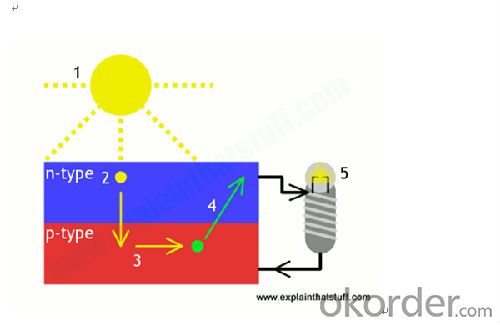
A solar cell is a sandwich of n-type silicon (blue) and p-type silicon (red). It generates electricity by using sunlight to make electrons hop across the junction between the different flavors of silicon:
When sunlight shines on the cell, photons (light particles) bombard the upper surface.
The photons (yellow blobs) carry their energy down through the cell.
The photons give up their energy to electrons (green blobs) in the lower, p-type layer.
The electrons use this energy to jump across the barrier into the upper, n-type layer and escape out into the circuit.
Flowing around the circuit, the electrons make the lamp light up.
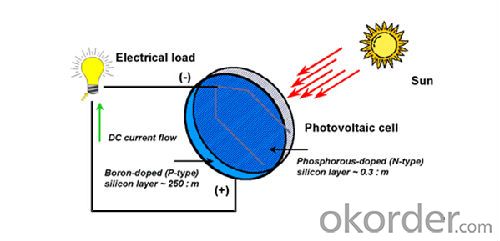
Working of PV cells
A typical silicon PV cell is composed of a thin wafer consisting of an ultra-thin layer of phosphorus-doped (N-type) silicon on top of a thicker layer of boron-doped (P-type) silicon. An electrical field is created near the top surface of the cell where these two materials are in contact, called the P-N junction. When sunlight strikes the surface of a PV cell, this electrical field provides momentum and direction to light-stimulated electrons, resulting in a flow of current when the solar cell is connected to an electrical load
- Q: Are solar cells impacted by shading?
- Yes, solar cells are significantly impacted by shading. When a solar cell is partially shaded, even with a small amount of shading, it can cause a considerable reduction in the overall energy output of the solar panel. This is because shading interrupts the flow of sunlight to the cells, leading to a decrease in their efficiency and power generation capacity. Therefore, it is important to ensure that solar panels are installed in unshaded areas to maximize their performance.
- Q: What is the role of solar cell inverters in grid-tied systems?
- The role of solar cell inverters in grid-tied systems is to convert the direct current (DC) electricity generated by the solar panels into alternating current (AC) electricity that can be used by the household or fed back into the electric grid. In addition to converting the electricity, solar cell inverters also monitor and control the flow of power, ensuring the system operates safely and efficiently.
- Q: Can solar cells be used in oil and gas exploration?
- Yes, solar cells can be used in oil and gas exploration. They can be utilized to power various equipment and devices used in the exploration process, such as remote monitoring systems, data loggers, and communication systems. Solar cells offer a sustainable and renewable energy solution, reducing the reliance on traditional fuel sources and minimizing the environmental impact of exploration operations.
- Q: What is the environmental impact of solar cell production?
- The environmental impact of solar cell production is generally considered to be lower compared to other forms of energy production. While the production of solar cells does require the extraction and processing of raw materials, such as silicon, the overall carbon footprint and pollution associated with solar panel manufacturing is significantly lower compared to fossil fuel-based energy sources. Additionally, solar panels have a long lifespan and produce clean, renewable energy once installed, which helps offset the initial environmental impact of their production.
- Q: Can solar cells be used in charging electric bikes?
- Yes, solar cells can be used to charge electric bikes. By connecting solar panels to the bike's battery, the energy from the sun can be converted into electricity, providing a renewable and sustainable source of power for the bike's charging needs.
- Q: What is the solar cell?
- When the surface of the solar cell and the electrode on the back side are connected with each other, a current flows.
- Q: How do solar cells handle power fluctuations?
- Solar cells handle power fluctuations through a process called maximum power point tracking (MPPT), which optimizes the output power of the cell. MPPT algorithms continuously monitor the voltage and current of the solar cell and adjust the load resistance to ensure that the cell operates at its maximum power point, even in the presence of fluctuations in solar irradiance or temperature. This allows solar cells to efficiently convert sunlight into electricity and adapt to changing environmental conditions.
- Q: Is solar cell technology very developed and v applied to life a lot?
- Yes, solar cells are very commonly used in the commercial military, industrial, areas.
- Q: Can solar cells be used in shopping malls?
- Yes, solar cells can definitely be used in shopping malls. They are a sustainable and environmentally-friendly source of energy that can be integrated into the mall's infrastructure to reduce electricity costs and carbon footprint.
- Q: How does solar cell technology apply to our daily life?
- Solar cells are used to make solar modules which generate electrical power from sunlight,
Send your message to us
Monocrystalline Solar Cell for Solar PV Panel
- Loading Port:
- China main port
- Payment Terms:
- TT or LC
- Min Order Qty:
- 10000 watt
- Supply Capability:
- 10000000 watt/month
OKorder Service Pledge
OKorder Financial Service
Similar products
Hot products
Hot Searches
Related keywords
